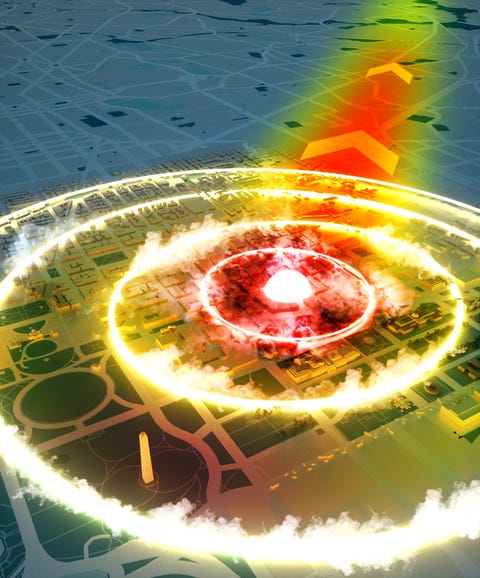What To Do in a Nuclear Attack
Not that it’s going to happen, but because it could.

SINELAB
We’ve seen what North Korea can do, and even though it hasn’t been in the news lately, the experts we consulted say that terrorists are still trying to get dirty bombs into the country. The threat of a nuclear attack on the United States is higher than it’s been since Berlin had a wall down its center. But what would that attack entail? What kind of damage would a nuclear bomb cause, and what, if anything, could we do to get ready for it?
How the Attack Spreads
1. The initial shock wave lessens after the first ring, but will still demolish most residential buildings and cause widespread casualties.
2. The fireball created by a nuclear bomb can reach tens of millions of degrees.
3. The blast sends a shock wave that would destroy nearly everyone and everything within this first ring.
4. If the bomb is detonated in the air, as opposed to on the ground, 50% to 90% of people in this area will die from radiation exposure without medical treatment.
5. With a 10- kiloton bomb, everyone within the outermost ring in the image above would receive third-degree burns from thermal radiation.
Who Would Do It
Terrorists: According to Jeff Schlegelmilch, deputy director of the National Center for Disaster Preparedness at Columbia University, the most likely nuclear weapon will be trucked in and exploded on the ground. He estimates its yield at 10 to 15 kilotons—the same as Hiroshima. “This type of threat is very survivable,” he says. “It would be bad, but the republic would survive.”
North Korea: For a long time, North Korea’s nuclear threat was capped in the 10- to 15-kiloton range. But earlier this year, says Michael Elleman, senior fellow for missile defense at the International Institute for Strategic Studies and an analyst for 38 North, a North Korea-tracking site, “North Korea detonated a thermonuclear weapon with a yield ranging between 150 kilotons and 250 kilotons. The tested weapon very likely could be fit on the HS-15,” the ICBM the country tested in November, “which could reach most, if not all, of the U.S. mainland.”
What Would Happen

A nuclear explosion that occurs on the ground creates a smaller shock wave than an airburst, but also sends a mushroom cloud of radioactive material into the air, where it is carried for miles by the wind.
SINELAB
Fireball: Whether the nuke is detonated in the air or on the ground, the initial threat is the fireball, which can reach tens of millions of degrees. “If you’re within that, you’re dead,” Schlegelmilch says. According to an online simulation created by Alex Wellerstein at the Stevens Institute of Technology (it’s interactive, scary, and fun), a 10-kiloton bomb would produce a fireball with a radius of 500 to 650 feet.
Shock wave: After the fireball comes the shock wave, or air blast. If detonated in the air, that same 10-kiloton bomb would destroy most buildings and kill nearly everyone within 0.38 miles of ground zero. The effect is reduced by 23 percent if the detonation occurs on the ground. The shock wave weakens from there, but can still take out residential buildings and cause mass casualties two to two and a half times the initial spread of the shock wave, according to Wellerstein’s projections.
Radiation: If you survive the fireball and shock wave, now you have to avoid the radiation. Exposure within three quarters of a mile of that 10-kiloton bomb, Wellerstein shows, will kill up to 90 percent of people without medical treatment. For a quarter-mile past that, your chances of survival increase, but you’ll get third-degree burns, which you probably won’t feel, because the radiation also kills your pain receptors.
Fallout: If the attack comes from the ground, dirt and debris are irradiated and shot into the air by the explosion, forming the classic mushroom cloud. Winds can carry the radiation, called nuclear fallout, from that cloud tens or hundreds of miles away, depending on the size of the bomb and the strength of the wind. As it falls back to earth, it sickens more people.
What You Should Do
“The good news is, if you make it through the blast and shock wave, you are now in a survivable situation,” Schlegelmilch says. If you’re close to the blast you need to get to a shelter. “At best, you have 15 to 20 minutes before the fallout starts to come back down,” he says. “If you’re farther out, you could have more time, but the reality is, you aren’t going to have time to evaluate the situation. If you see a nuclear flash, the first thing to do is get behind a barrier in case the shock wave comes. Then get to the inner part of a building. Ideally you’d be protected by thick concrete, underground if possible. Glass and most metals won’t provide you much protection.” If the explosion was ground based, you can also protect yourself by getting above the blast—usually higher than the ninth floor of a building. Be sure to stay near the center of the building in a room with substantial walls.
"IF YOU MAKE IT THROUGH THE BLAST AND SHOCK WAVE, YOU ARE NOW IN A SURVIVABLE SITUATION.”
No comments:
Post a Comment